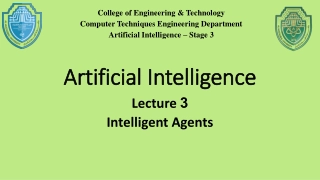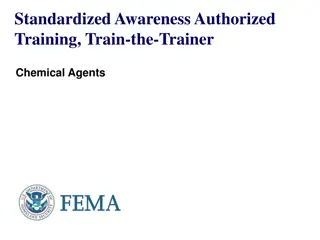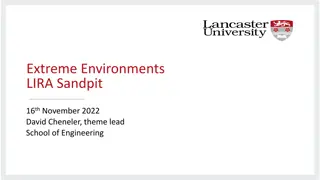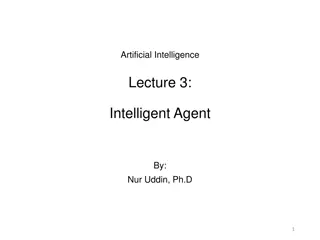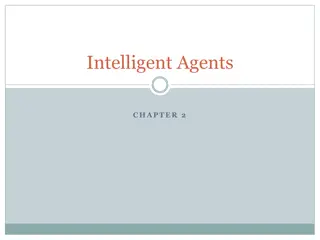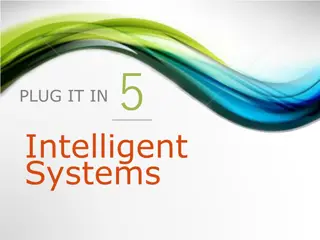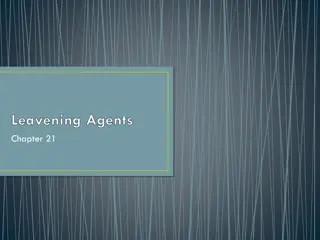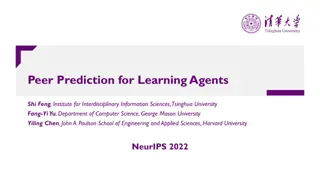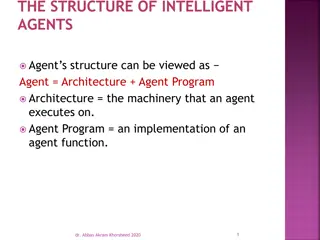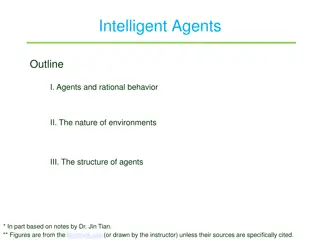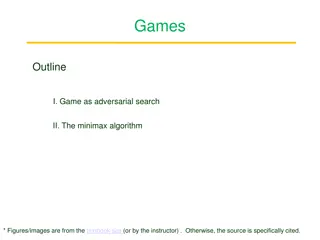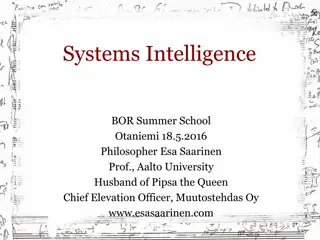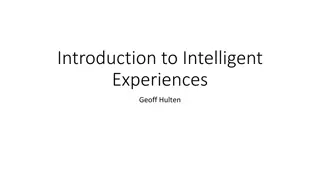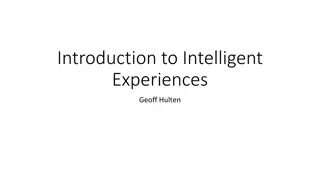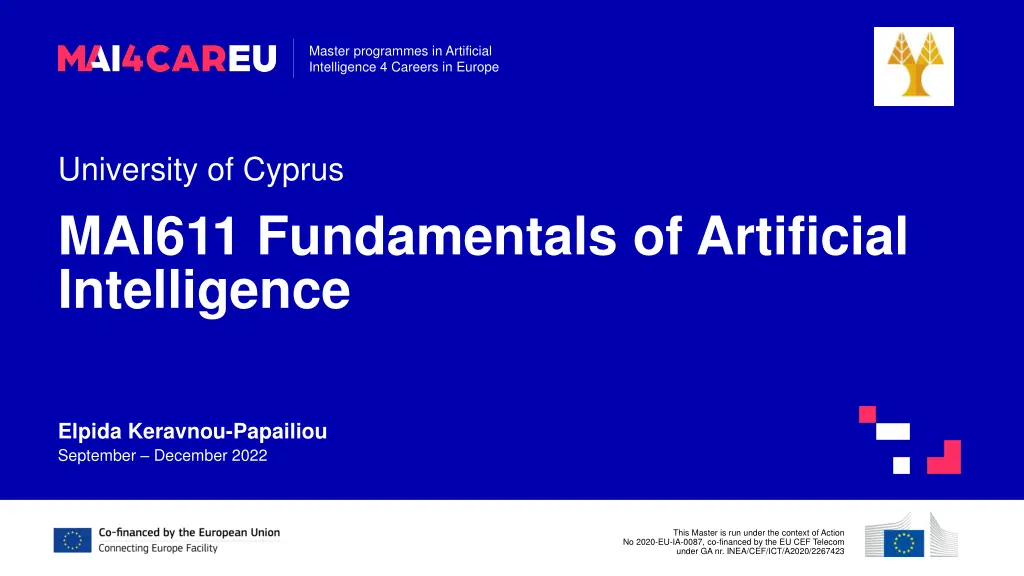
Intelligent Agents and Multiagent Systems in Master Programmes
Explore the fundamentals of intelligent agents and multiagent systems in the context of Master Programmes in Artificial Intelligence for promising careers in Europe. Learn about defining intelligent agents, analyzing rationality, discussing abstract and concrete architectures, outlining learning agents, explaining multiagent systems, analyzing communication and coordination, and exploring communication protocols. This Master program is co-financed by the EU CEF Telecom.
Download Presentation

Please find below an Image/Link to download the presentation.
The content on the website is provided AS IS for your information and personal use only. It may not be sold, licensed, or shared on other websites without obtaining consent from the author. If you encounter any issues during the download, it is possible that the publisher has removed the file from their server.
You are allowed to download the files provided on this website for personal or commercial use, subject to the condition that they are used lawfully. All files are the property of their respective owners.
The content on the website is provided AS IS for your information and personal use only. It may not be sold, licensed, or shared on other websites without obtaining consent from the author.
E N D
Presentation Transcript
Master programmes in Artificial Intelligence 4 Careers in Europe University of Cyprus MAI611 Fundamentals of Artificial Intelligence Elpida Keravnou-Papailiou September December 2022 This Master is run under the context of Action No 2020-EU-IA-0087, co-financed by the EU CEF Telecom under GA nr. INEA/CEF/ICT/A2020/2267423
Master programmes in Artificial Intelligence 4 Careers in Europe Intelligent Agents and Multiagent Systems This Master is run under the context of Action No 2020-EU-IA-0087, co-financed by the EU CEF Telecom under GA nr. INEA/CEF/ICT/A2020/2267423
Master programmes in Artificial Intelligence 4 Careers in Europe UNIT 4 Intelligent Agents and Multiagent Systems CONTENTS 1. Intelligent Agents 2. Multiagent Systems This Master is run under the context of Action No 2020-EU-IA-0087, co-financed by the EU CEF Telecom under GA nr. INEA/CEF/ICT/A2020/2267423 3
Master programmes in Artificial Intelligence 4 Careers in Europe INTENDED LEARNING OUTCOMES Upon completion of this unit on intelligent agents and multiagent systems, students will be able: Regarding intelligent agents: 1. To define and explain what an intelligent (autonomous) agent is and to discuss its characteristics. 2. To analyze the notion of rationality with respect to intelligent agents and to overview the relation between information gathering, autonomy and learning. 3. To list the properties of an environment where an agent is situated. 4. To discuss abstract architectures for intelligent agents and distinguish the category of agents with internal state. 5. To discuss concrete architectures for intelligent agents, namely a logic-based architecture, a reactive architecture, the Belief-Desire-Intention architecture and layered architectures and to point out strengths and weaknesses of these architectures. 6. To outline a learning agent and to overview its learning element. This Master is run under the context of Action No 2020-EU-IA-0087, co-financed by the EU CEF Telecom under GA nr. INEA/CEF/ICT/A2020/2267423 4
Master programmes in Artificial Intelligence 4 Careers in Europe INTENDED LEARNING OUTCOMES Upon completion of this unit on intelligent agents and multiagent systems, students will be able: Regarding multiagent systems: 1. To explain how the need for multiagent systems arise and to list the characteristics of the environments of multiagent systems. 2. To analyze communication and interaction between agents, how agents may be coordinated to achieve coherence, what the dimensions of the meaning associated with communication are, and what the formal communication elements are. 3. To discuss the role of the agents in a dialogue and to give the types of messages between agents. 4. To list the principal communication protocols and overview the Knowledge Query and Manipulation Language (KQMF), its protocol, and the Knowledge Interchange Format (KIF). 5. To explain the Cooperation protocol and the steps in the Contract Net protocol which is a main cooperation protocol. 6. To discuss the Blackboard system. 7. To outline the Negotiation protocol and to list the principal features of a society of agents. This Master is run under the context of Action No 2020-EU-IA-0087, co-financed by the EU CEF Telecom under GA nr. INEA/CEF/ICT/A2020/2267423 5
Master programmes in Artificial Intelligence 4 Careers in Europe Intelligent Agents Largely adapted from M. Wooldridge s chapter in G. Weiss (ed.) Multiagent Systems, The MIT Press, 2013 This Master is run under the context of Action No 2020-EU-IA-0087, co-financed by the EU CEF Telecom under GA nr. INEA/CEF/ICT/A2020/2267423
Master programmes in Artificial Intelligence 4 Careers in Europe The general term Agent A person or thing that acts or makes an effort Some physical force that acts on a case-by-case basis causing some results A person (or company) authorized to do a job for someone else A person acting on behalf of another to achieve a legitimate relationship between that other and a third party This Master is run under the context of Action No 2020-EU-IA-0087, co-financed by the EU CEF Telecom under GA nr. INEA/CEF/ICT/A2020/2267423 7
Master programmes in Artificial Intelligence 4 Careers in Europe Definition of the term Agent given by FIPA (Foundation for Intelligent Physical Agents) The Foundation for Intelligent Physical Agents (FIPA) is a body for developing and setting computer software standards for heterogeneous and interacting agents and agent-based systems. An agent is the fundamental unit of action (actor) in an area. It combines one or more service capabilities into a unified, integral execution model, which may include access to external software, users, and communication mechanisms. This Master is run under the context of Action No 2020-EU-IA-0087, co-financed by the EU CEF Telecom under GA nr. INEA/CEF/ICT/A2020/2267423 8
Master programmes in Artificial Intelligence 4 Careers in Europe AI-based specification of the term Agent Many applications require systems that can decide autonomously what they need to do to meet their design goals These computer systems are referred to as agents This Master is run under the context of Action No 2020-EU-IA-0087, co-financed by the EU CEF Telecom under GA nr. INEA/CEF/ICT/A2020/2267423 9
Master programmes in Artificial Intelligence 4 Careers in Europe Intelligent or Autonomous Agent Operates with resistance to rapidly changing, unpredictable or open environments, where there is a high probability of failure. Example Applications of Intelligent Agents Navigation of spacecraft from Earth to space Greater autonomy in making immediate decisions under unforeseen circumstances Search for information on the internet This Master is run under the context of Action No 2020-EU-IA-0087, co-financed by the EU CEF Telecom under GA nr. INEA/CEF/ICT/A2020/2267423 10
Agent and its Environment AGENT action sensor output input ENVIRONMENT Often the interaction is ongoing and non- terminating This Master is run under the context of Action No 2020-EU-IA-0087, co-financed by the EU CEF Telecom under GA nr. INEA/CEF/ICT/A2020/2267423 11
An agent . .. is a computer system that is situated in some environment and that is capable to act autonomously in this environment in order to achieve its delegated objectives. This Master is run under the context of Action No 2020-EU-IA-0087, co-financed by the EU CEF Telecom under GA nr. INEA/CEF/ICT/A2020/2267423 12
Master programmes in Artificial Intelligence 4 Careers in Europe Environment and Agent At best the agent has some control over the environment, in the sense that it can influence it The same action in seemingly identical situations may have different effects or may fail to lead to the desired effect Non-deterministic environments Ability to handle failure Actions have preconditions This Master is run under the context of Action No 2020-EU-IA-0087, co-financed by the EU CEF Telecom under GA nr. INEA/CEF/ICT/A2020/2267423 13
Master programmes in Artificial Intelligence 4 Careers in Europe Classification of Environment Properties Accessible vs inaccessible Does the agent have complete, accurate and up-to-date information on the state of the environment? Deterministic vs non-deterministic Can the state in which an action leads be determined with certainty? Episodic vs non-episodic (sequential) Can the agent decide its current action solely based on the current episode (and not its effects on future episodes)? If yes, the agent does not need to think ahead. In a sequential environment short-term actions can have long-term consequences. This Master is run under the context of Action No 2020-EU-IA-0087, co-financed by the EU CEF Telecom under GA nr. INEA/CEF/ICT/A2020/2267423 14
Master programmes in Artificial Intelligence 4 Careers in Europe Classification of Environment Properties (cont.) Static vs dynamic Does it remain stable or not beyond the effects of the agent's actions? A dynamic environment can change while the agent is deliberating. Discrete vs continuous Is the set of actions and percepts specific and finite? Percept means the content an agent s sensors are perceiving If an agent s actions need to depend on the entire percept sequence, the agent will have to remember the percepts. This Master is run under the context of Action No 2020-EU-IA-0087, co-financed by the EU CEF Telecom under GA nr. INEA/CEF/ICT/A2020/2267423 15
Master programmes in Artificial Intelligence 4 Careers in Europe The most complex environment category Inaccessible Non-deterministic Non-episodic Dynamic Continuous This Master is run under the context of Action No 2020-EU-IA-0087, co-financed by the EU CEF Telecom under GA nr. INEA/CEF/ICT/A2020/2267423 16
Master programmes in Artificial Intelligence 4 Careers in Europe Examples of Agents Any control system, e.g., a thermostat (inhabits a physical environment) too cold heating on temperature OK heating off Most software daemons (e.g., the background processes in the Unix operating system) which monitor a software environment and perform actions to modify it e.g., the xbiff program (inhabits a software environment) The above are not intelligent agents! This Master is run under the context of Action No 2020-EU-IA-0087, co-financed by the EU CEF Telecom under GA nr. INEA/CEF/ICT/A2020/2267423 17
Master programmes in Artificial Intelligence 4 Careers in Europe Intelligent Agents Capable of flexible autonomous operation to achieve its delegated objectives Meanings of flexibility Reactivity: Ability to perceive the environment and respond to changes in a timely manner in order to satisfy their delegated objectives Pro-activeness: Ability to exhibit goal-driven behavior by taking the initiative to satisfy their delegated objectives Social ability: Ability to interact with other agents (and possibly humans) in order to satisfy their design objectives This Master is run under the context of Action No 2020-EU-IA-0087, co-financed by the EU CEF Telecom under GA nr. INEA/CEF/ICT/A2020/2267423 18
Master programmes in Artificial Intelligence 4 Careers in Europe Intelligent Agents must be Rational A rational agent is one that behaves as well as possible, i.e., one that does the right thing How well an agent behaves depends on the nature of the environment Evaluate an agent s behavior on its consequences If an agent s actions cause the environment to go into desirable states, then the agent performs well Defining a rational agent: A rational agent, for each possible percept, should select an action that is expected to maximize its performance measure, given by the evidence provided by the percept sequence and whatever built-in knowledge the agent has Hence rationality maximizes expected performance where a rational choice depends on the percept sequence to date. This Master is run under the context of Action No 2020-EU-IA-0087, co-financed by the EU CEF Telecom under GA nr. INEA/CEF/ICT/A2020/2267423 19
Master programmes in Artificial Intelligence 4 Careers in Europe Information gathering, Autonomy and Learning Information gathering is an important part of rationality Doing actions in order to modify future percepts Learn as much as possible from what it perceives; through experiential learning, the agent s prior knowledge of the environment may be modified and augmented A rational agent should be autonomous A rational agent, through its ability to learn what it can, compensates for partial or incorrect prior knowledge An agent relying entirely on prior knowledge rather than its own percepts and learning process, lacks autonomy This Master is run under the context of Action No 2020-EU-IA-0087, co-financed by the EU CEF Telecom under GA nr. INEA/CEF/ICT/A2020/2267423 20
Master programmes in Artificial Intelligence 4 Careers in Europe Agents and Objects An object executes the requested method. Instead, an agent decides for itself whether to execute the request it receives Objects do it for free; agents do it for money It is understood that agents can be implemented using object-oriented techniques The standard object-oriented model does not refer to autonomous, flexible action; objects are simple passive service providers, incapable of reactive, proactive or social behavior A system of multiple agents is "multi-threaded" since each agent has its own thread of control and is continually executing This Master is run under the context of Action No 2020-EU-IA-0087, co-financed by the EU CEF Telecom under GA nr. INEA/CEF/ICT/A2020/2267423 21
Master programmes in Artificial Intelligence 4 Careers in Europe Agents and Expert Systems Expert Systems were the most important AI technology of the 1980s An expert system can solve problems or give advice in some knowledge-rich domain An expert system usually does not have direct interaction with any environment, hence expert systems are inherently disembodied It does not receive its data through sensors but through a user It does not act on any environment, but provides feedback or advice to a third party It is not generally required for an expert system to co-operate with other agents Exceptions are expert systems that perform real-time control tasks This Master is run under the context of Action No 2020-EU-IA-0087, co-financed by the EU CEF Telecom under GA nr. INEA/CEF/ICT/A2020/2267423 22
Master programmes in Artificial Intelligence 4 Careers in Europe Abstract Architectures for Intelligent Agents Environment States S = {s1, s2, } At all times, the environment is in one of these states Agent Actions = { 1, 2, } Abstract view of a standard agent action: S* A as a function that maps sequences of environmental states to actions This Master is run under the context of Action No 2020-EU-IA-0087, co-financed by the EU CEF Telecom under GA nr. INEA/CEF/ICT/A2020/2267423 23
Master programmes in Artificial Intelligence 4 Careers in Europe Environment Behavior env: S A Power(S) If in each case env(s, a) gives a unique state, then the behaviour of the environment is deterministic. Otherwise, it is non-deterministic where the possible successive states from the execution of a given action in a given state are identified. This Master is run under the context of Action No 2020-EU-IA-0087, co-financed by the EU CEF Telecom under GA nr. INEA/CEF/ICT/A2020/2267423 24
Master programmes in Artificial Intelligence 4 Careers in Europe Agent Environment Interaction History The sequence 0 1 2 3 u-1 u h : s0 s1 s2 s3 . su is a possible history of the agent's interaction with the environment if and only if the following conditions are true: u N, u= action((s0,s1,...,su)) u N s.t. u > 0, su env(su-1, u-1) This Master is run under the context of Action No 2020-EU-IA-0087, co-financed by the EU CEF Telecom under GA nr. INEA/CEF/ICT/A2020/2267423 25
Master programmes in Artificial Intelligence 4 Careers in Europe Characteristic Behavior of an Agent It is the sum of all possible interaction histories hist(agent, environment) If a property is valid in all possible histories, then this property is an invariant property of the agent in the environment If and only if hist(ag1, env) = hist(ag2, env), agents ag1 and ag2 have equivalent behavior in environment env. If this is the case for any environment, then the two agents have equivalent behavior Usually, an agent's interaction with its environment never ends and therefore its history is infinite This Master is run under the context of Action No 2020-EU-IA-0087, co-financed by the EU CEF Telecom under GA nr. INEA/CEF/ICT/A2020/2267423 26
Master programmes in Artificial Intelligence 4 Careers in Europe Purely Reactive Agents They decide to act without reference to their history - every decision is based solely on the present without any reference to the past action: S A Example: the thermostat For every "purely reactive agent" there is an equivalent "standard agent", but not the opposite This Master is run under the context of Action No 2020-EU-IA-0087, co-financed by the EU CEF Telecom under GA nr. INEA/CEF/ICT/A2020/2267423 27
Master programmes in Artificial Intelligence 4 Careers in Europe Perception An agent must have the ability to observe/perceive its environment: see: S P, where P is the set of observations/percepts It is implemented in hardware in the case of agents that are integrated in a physical world (e.g., video camera, infra-red sensors for mobile robots) In the case of "software agents" it consists of commands to extract information about the "software environment" This Master is run under the context of Action No 2020-EU-IA-0087, co-financed by the EU CEF Telecom under GA nr. INEA/CEF/ICT/A2020/2267423 28
Master programmes in Artificial Intelligence 4 Careers in Europe Respecifying function action action: P * A The action function represents the agent's decision-making process In the revised version it maps sequences of "percepts" to actions Let s1 S and s2 S, where s1 s2. If see (s1) = see (s2) from the agent s perspective the two environment states s1 and s2 are indistinguishable from each other This Master is run under the context of Action No 2020-EU-IA-0087, co-financed by the EU CEF Telecom under GA nr. INEA/CEF/ICT/A2020/2267423 29
action see AGENT ENVIRONMENT This Master is run under the context of Action No 2020-EU-IA-0087, co-financed by the EU CEF Telecom under GA nr. INEA/CEF/ICT/A2020/2267423 30
Master programmes in Artificial Intelligence 4 Careers in Europe Distinguishing Environment States Let s and s S. The relation means see(s) = see(s ). This relation therefore divides S into mutually indistinguishable sets of states from the agent s perspective. If | | = |S| then the agent can distinguish every state of the environment and therefore has a perfect perception of the environment (omniscient agent). If | | = 1 then the agent has no perception at all since it is not able to distinguish any state - from the agent s perspective all states are the same. This Master is run under the context of Action No 2020-EU-IA-0087, co-financed by the EU CEF Telecom under GA nr. INEA/CEF/ICT/A2020/2267423 31
Master programmes in Artificial Intelligence 4 Careers in Europe Agents with internal State They have an internal data structure that records information about the state of the environment and history I is the set of the agent's internal states see: S P action: I A next: I P I This Master is run under the context of Action No 2020-EU-IA-0087, co-financed by the EU CEF Telecom under GA nr. INEA/CEF/ICT/A2020/2267423 32
action see next state AGENT ENVIRONMENT This Master is run under the context of Action No 2020-EU-IA-0087, co-financed by the EU CEF Telecom under GA nr. INEA/CEF/ICT/A2020/2267423 33
Master programmes in Artificial Intelligence 4 Careers in Europe Agents with internal State The agent has some initial internal state, i0 It then observes the state of environment s and generates its perceptions - see(s) What follows is the update of the agent's internal state - next(i0, see (s)) Then the action is decided - action(next(i0, see (s))) The action is executed and the see next action cycle is repeated This Master is run under the context of Action No 2020-EU-IA-0087, co-financed by the EU CEF Telecom under GA nr. INEA/CEF/ICT/A2020/2267423 34
Master programmes in Artificial Intelligence 4 Careers in Europe Agents with State versus Standard Agents They are just as powerful Their power of expressiveness is identical Any agent with internal state can be turned into a standard agent with equivalent behavior This Master is run under the context of Action No 2020-EU-IA-0087, co-financed by the EU CEF Telecom under GA nr. INEA/CEF/ICT/A2020/2267423 35
Master programmes in Artificial Intelligence 4 Careers in Europe Concrete Architectures for Intelligent Agents Logic-based architectures Decision making is done through logical deduction Reactive Architectures Decision making is done through the direct mapping of state to action Belief-Desire-Intention Architectures Decision making is based on the processing of data structures that represent the agent's beliefs, wishes and intentions Layered Architectures Decision making is based on different levels of software that perform reasoning in relation to the environment from different levels of abstraction This Master is run under the context of Action No 2020-EU-IA-0087, co-financed by the EU CEF Telecom under GA nr. INEA/CEF/ICT/A2020/2267423 36
Master programmes in Artificial Intelligence 4 Careers in Europe Logic-Based Architectures Logic-based agents may be referred to as deliberate agents: Such agents maintain an internal database of predicate logic sentences, representing in symbolic form the information they have about their environment, just like the beliefs in humans. L, the set of predicate logic sentences D = P(L), the set of the internal states of the agent ( , 1, , D) its database , the deductive rules of inference , formula can be proved from the database of sentences using only the rules of inference see : S P next : D P D action : D A This Master is run under the context of Action No 2020-EU-IA-0087, co-financed by the EU CEF Telecom under GA nr. INEA/CEF/ICT/A2020/2267423 37
Action Selection in Deliberate Agents function action ( , ) returns an action begin for each A do if Do( ) then return for each A do if ~Do( ) then return return null end function action This Master is run under the context of Action No 2020-EU-IA-0087, co-financed by the EU CEF Telecom under GA nr. INEA/CEF/ICT/A2020/2267423 38
Master programmes in Artificial Intelligence 4 Careers in Europe Logic-Based Architectures Strengths: The "elegance" and clean semantics of logic Serious weaknesses: The computational complexity of proving theorems calls into question the effectiveness of this approach in environments where time is limited The assumption of "calculative rationality" that the world will not change substantially while the agent ponders what to do, and that an action that is rational when reasoning begins will continue to be rational when reasoning is complete does not always apply This Master is run under the context of Action No 2020-EU-IA-0087, co-financed by the EU CEF Telecom under GA nr. INEA/CEF/ICT/A2020/2267423 39
Master programmes in Artificial Intelligence 4 Careers in Europe Reactive Architectures They are based on the rejection of any symbolic representation and its management mechanisms They are rooted on the belief that intelligent behavior can result from the combination of many basic actions and the way an agent interacts with its environment hence intelligent, rational behavior is seen as innately linked to the environment an agent occupies Reactive: reacting to an environment without reasoning about it Alternative terms: behavioral (developing and combining individual behaviors) or situated (in some environment rather than being disembodied from it) This Master is run under the context of Action No 2020-EU-IA-0087, co-financed by the EU CEF Telecom under GA nr. INEA/CEF/ICT/A2020/2267423 40
Master programmes in Artificial Intelligence 4 Careers in Europe Basic Characteristics of Reactive Agents Simplicity and interaction in a basic way, but from which complex behavior emerges It consists of various components that operate autonomously and are responsible for specific tasks The communication between these components is the minimum possible and quite low level Operates with the processing of elementary representations, such as data coming from various sensors This Master is run under the context of Action No 2020-EU-IA-0087, co-financed by the EU CEF Telecom under GA nr. INEA/CEF/ICT/A2020/2267423 41
Master programmes in Artificial Intelligence 4 Careers in Europe Rodney Brooks Subsumption Architecture An agent s decision making is realized through a set of task accomplishing behaviors (implemented as finite-state machines) Each behavior is an individual action selection process, which continually takes perceptual input and maps it to an action to perform Many behaviors can fire simultaneously Behaviors are arranged in layers forming a subsumption hierarchy, where lower layers in the hierarchy can inhibit higher layers the lower a layer is the higher is its priority This Master is run under the context of Action No 2020-EU-IA-0087, co-financed by the EU CEF Telecom under GA nr. INEA/CEF/ICT/A2020/2267423 42
Subsumption Architecture (best known reactive agent architecture) p e r c e p t u a l action computation exploring wandering i n p u t action obstacle avoidance This Master is run under the context of Action No 2020-EU-IA-0087, co-financed by the EU CEF Telecom under GA nr. INEA/CEF/ICT/A2020/2267423 43
Master programmes in Artificial Intelligence 4 Careers in Europe Behavior Rules Set of behaviors in the form of rules situation action Beh = {(c, ) | c P and A} A behavior (c, ) can be activated when the environment is in state s S, if and only if see(s) c inhibition relation ( ) R R, where R Beh (b1,b2) , means b1inhibits b2 , i.e., b1is at a lower layer than b2and hence it has priority This Master is run under the context of Action No 2020-EU-IA-0087, co-financed by the EU CEF Telecom under GA nr. INEA/CEF/ICT/A2020/2267423 44
Action Selection in the Subsumption Architecture function action (p : Percept) returns an action var fired : Power(R) begin fired := {(c, ) | (c, ) R and p c } for each (c, ) fired do if ~( (c , ) fired s.t. (c , ) (c, ) then return return null end function action This Master is run under the context of Action No 2020-EU-IA-0087, co-financed by the EU CEF Telecom under GA nr. INEA/CEF/ICT/A2020/2267423 45
Master programmes in Artificial Intelligence 4 Careers in Europe Advantages of Reactive Architectures Simplicity, economy, computational tractability, robustness against failure, elegance Fundamental weaknesses As agents do not employ models of their environment, they must have sufficient local information to determine acceptable actions Since non-local information cannot be considered, the decision making has an inherently short- term view There is no principled methodology for building such agents experimentation, trial and error The essence of the architecture suggests that the relationship between individual behaviors, environment and overall behavior is not understandable, given that the claim is that overall behavior emerges from component behaviors Hard to build agents with many layers as the behavior interaction dynamic become too complex This Master is run under the context of Action No 2020-EU-IA-0087, co-financed by the EU CEF Telecom under GA nr. INEA/CEF/ICT/A2020/2267423 46
Master programmes in Artificial Intelligence 4 Careers in Europe Belief-Desire-Intention Architectures They are based on the principles of practical reasoning, i.e., the decision-making, at all times, focuses on the action to be taken to advance the pursued goals Two important processes are involved Deliberation: decide the goals to be achieved Means-ends reasoning: decide how to achieve these goals This Master is run under the context of Action No 2020-EU-IA-0087, co-financed by the EU CEF Telecom under GA nr. INEA/CEF/ICT/A2020/2267423 47
Master programmes in Artificial Intelligence 4 Careers in Europe Intentions play a crucial role They drive the "means-ends reasoning Constrain future "deliberation" They persist They influence the beliefs on which future practical reasoning is based Reconsidering Intentions If the agent does not reconsider its intentions regularly, there is a risk that it will continue to pursue unrealistic intentions or intentions for which there is no longer any reason to achieve If the agent constantly reconsiders its intentions, there is a risk that there will not be enough time to pursue them and as a result they can never be achieved This Master is run under the context of Action No 2020-EU-IA-0087, co-financed by the EU CEF Telecom under GA nr. INEA/CEF/ICT/A2020/2267423 48
Master programmes in Artificial Intelligence 4 Careers in Europe Reasoning Strategies They must consider the type of environment In a static non-changing environment, proactive goal-driven reasoning is enough In a dynamic environment, the ability to react to change and modify intentions is required The dilemma is how to balance proactive (goal-driven) and reactive (event-driven) behavior Bold agents never stop to reconsider Cautious agents constantly stop to reconsider Bold agents outperform cautious ones in environments that do not change quickly, while cautious agents outperform bold ones in environments that change frequently This Master is run under the context of Action No 2020-EU-IA-0087, co-financed by the EU CEF Telecom under GA nr. INEA/CEF/ICT/A2020/2267423 49
sensor input brf belief revision function beliefs generate options desires filter intentions action action XII- 50 This Master is run under the context of Action No 2020-EU-IA-0087, co-financed by the EU CEF Telecom under GA nr. INEA/CEF/ICT/A2020/2267423 output

